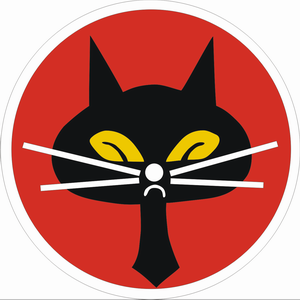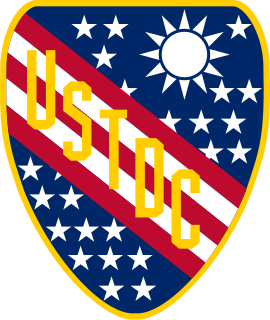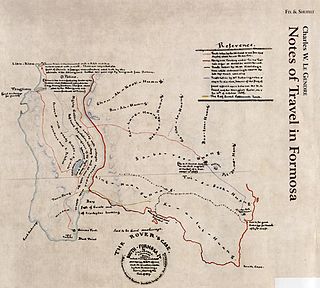 W
WThe 21st Fighter Squadron is part of the 56th Operations Group at Luke Air Force Base, Arizona. It is a United States Air Force squadron that operates Taiwanese-owned General Dynamics F-16 Fighting Falcon aircraft conducting fighter and maintenance training for the pilots and maintainers of the Republic of China Air Force.
 W
WBlack Bat Squadron, formally the 34th Squadron, was a squadron of CIA reconnaissance plane pilots and crew based in Taiwan during the Cold War. Citizens of the Republic of China flew missions over mainland China controlled by the People's Republic of China (PRC) to drop agents and gather military signal intelligence around military sites. The 34th Squadron was formed in 1953 and flew its last operational mission in 1967. The squadron's emblem was a bat and seven stars surrounded by a red ring. The bat & stars allude to night operations. The bat's wing piercing the "red circle" intentionally and the position of the stars representing the numbers 3 & 4 for its formal name; the 34th Squadron of the ROC Air Force. The unit's aircraft included the Boeing B-17G, Douglas A-26C/B-26C Invader, 7 Lockheed RB-69A, Douglas C-54, 11 Fairchild C-123B/K Provider, Lockheed C-130E Hercules, and 3 "black" Lockheed P-3A Orion. The P-3As and RB-69As were armed with AIM-9 Sidewinder missiles for self-defense. 34th Squadron specialized in very low level air space penetration to hug the ground in order to evade enemy radars and fighter interceptions. Later when operating P-3A, its main mission was flying in international water, 40 miles outside of Mainland China, to collect signal intelligences.
 W
WThe Black Cat Squadron, formally the 35th Squadron, was a squadron of the Republic of China Air Force that flew the U-2 surveillance plane out of Taoyuan Air Base in northern Taiwan, from 1961 to 1974. 26 ROCAF pilots successfully completed U-2 training in the US and flew 220 operational missions, with about half over the People's Republic of China.
 W
WThe Cheng Kung-class frigates are guided-missile frigates (PFG) currently in service of the Republic of China (Taiwan) Navy (ROCN). They are based upon the U.S. Oliver Hazard Perry class and built by China Shipbuilding Corporation in Kaohsiung, Taiwan under license throughout the 1990s as parts of the "Kuang Hua One" patrol frigate, guided project. These frigates served as the mainstay of the ROCN's theater air defense prior to the ROCN's acquisition of Keelung (Kidd)-class destroyers in 2005.
 W
WThe United States Taiwan Defense Command was a sub-unified command of the United States armed forces operating in the Republic of China (ROC) on the island of Taiwan (Formosa).
 W
WThe First Taiwan Strait Crisis was a brief armed conflict between the Communist People's Republic of China (PRC) and the Nationalist Republic of China (ROC) in Taiwan. The Taiwan strait crisis began when the PRC seized the Yijiangshan Islands and forced the ROC to abandon the Tachen Islands, which were evacuated by the navies of the ROC and the US.
 W
WMajor non-NATO ally (MNNA) is a designation given by the United States government to close allies that have strategic working relationships with the US Armed Forces but are not members of the North Atlantic Treaty Organization (NATO). While the status does not automatically include a mutual defense pact with the United States, it still confers a variety of military and financial advantages that otherwise are not obtainable by non-NATO countries.
 W
WThe Operation King Kong (金剛計劃) was a joint military operation of the United States Navy and the Nationalist army of the Republic of China that started on the 8th February, 1955. The objective was to withdraw soldiers, people and military equipment and supplies from the Dachen archipelago, Pishan Island and Yushan Island to Taiwan.
 W
WThe Rover Incident occurred on 12 March 1867 when the American merchant ship Rover, captained by Joseph Hunt who was accompanied by his wife Mercy G. Beerman Hunt, and en route from Swatow to Newchwang, was wrecked off the coast of Formosa. The ship struck a coral reef called Chihsingyen near Oluanpi and drifted into the area of Kenting in modern-day Hengchun, Pingtung County, Taiwan. Fourteen American sailors, including Hunt and his wife, were killed by Taiwanese Aborigines in revenge for earlier killings of Kaolut (Koalut/Ku-a-lut/etc) tribe members by foreigners. Subsequently, the U.S. military decided to send a military expedition against the tribe members responsible.
 W
WThe Second Taiwan Strait Crisis, also called the 1958 Taiwan Strait Crisis, was a conflict that took place between the People's Republic of China (PRC) and the Republic of China (ROC). In this conflict, the PRC shelled the islands of Kinmen (Quemoy) and the Matsu Islands along the east coast of mainland China to "liberate" Taiwan from the Chinese Nationalist Party, also known as the Kuomintang (KMT); and to probe the extent of the United States defense of Taiwan's territory. A naval battle also took place around Dongding Island when the ROC Navy repelled an attempted amphibious landing by the PRC Navy.
 W
WThe Sino-American Mutual Defense Treaty (中美共同防禦條約), formally Mutual Defense Treaty between the United States of America and the Republic of China(中華民國與美利堅合眾國間共同防禦條約), was a defense pact between the United States of America and the Republic of China effective from 1955 to 1980. It essentially prevented the People's Republic of China from taking over the island of Taiwan. Some of its content was carried over to the Taiwan Relations Act of 1979.
 W
WThe Taihoku Air Raid that took place on 31 May 1945 was the largest Allied air raid on the city of Taihoku during World War II. Despite efforts by Allied planners to minimize civilian casualties, many residents were killed in the raid and tens of thousands wounded or displaced.